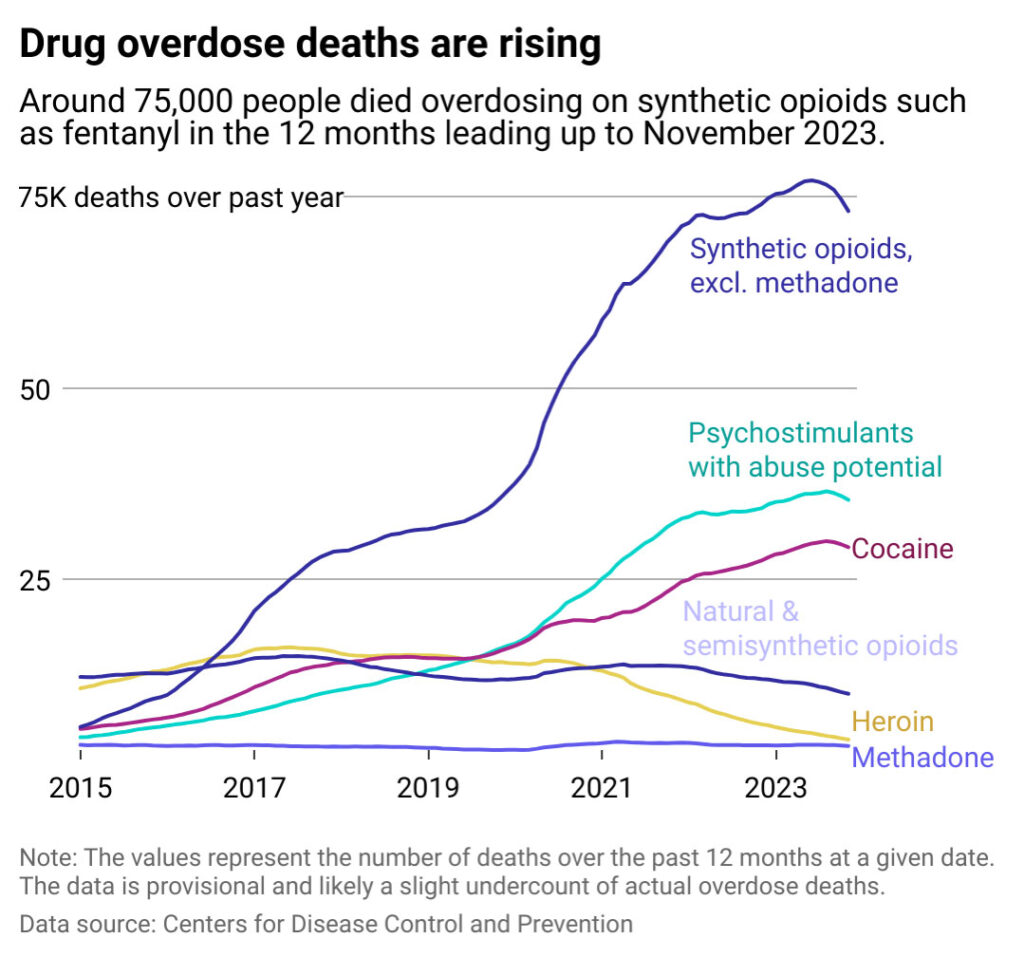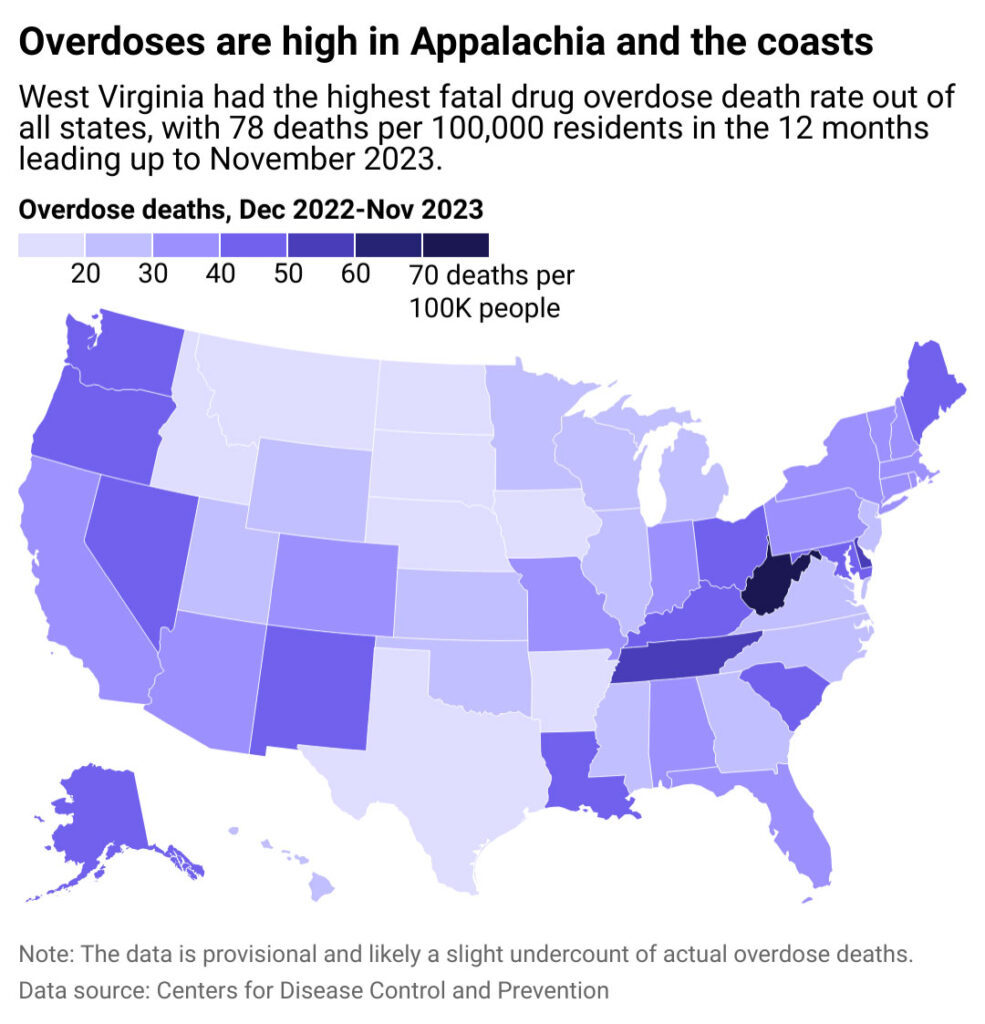Which States Have the Worst Substance Abuse Problems?
Counseling Schools Search
When you click on a sponsoring school or program advertised on our site, or fill out a form to request information from a sponsoring school, we may earn a commission. View our advertising disclosure for more details.
Accidental injuries, a category that includes drug overdoses, are the leading cause of death for Americans aged 18 to 45—a situation that seems unlikely to change any time soon.
A major contributing factor to this crisis is the opioid epidemic, which continues to ravage the country. More than 105,000 people died from a drug overdose in the 12-month period ending in November 2023, according to the latest data from the Centers for Disease Control and Prevention. This number is slightly lower than its peak in May of that same year but is twice the rate of 2015.
Counseling Schools looked at data from the CDC to see how the opioid epidemic is evolving across America. Since 2016, synthetic opioids like fentanyl have been the deadliest drug, accounting for over 80 percent of fatal overdoses.
Drug overdose deaths have been rising all across the country. As of 2023, coastal states and those in the Appalachian Mountains have been hit the hardest. Deadly drugs are especially prevalent in West Virginia, which suffered 78 deaths per 100,000 residents.

Counseling has been proven to reduce addiction rates more than criminalization. Learn how to earn your degree in addiction counseling or clinical psychology and provide comprehensive mental and behavioral healthcare.
Drug Deaths are Rising
The modern opioid crisis started in the 1990s, when drug companies began marketing prescription opioids such as Purdue’s OxyContin (oxycodone) for pain management while understating their addictive qualities. In a settlement with state and local governments, the Sackler family, which owns Purdue, agreed to pay $6 billion while giving up control of the company. In turn, the Sackler family would be immune from opioid-related civil lawsuits. The Supreme Court has frozen the settlement to consider whether courts had the authority to grant such protections to the Sackler family.
The recent rise of fentanyl has made the oxycodone crisis seem tame. This synthetic opioid is estimated to be between 50 to 100 times more potent than morphine—even a tiny dose can kill an adult, unlike oxycodone, and is primarily made illegally.
One reason fentanyl has had such a wide reach in America is that it is often mixed in with other drugs, such as heroin, meth, or ecstasy. This allows drug makers to create more powerful narcotics at a lower cost but makes it easy for consumers to misjudge doses.

Geography still matters in the counseling profession. Many careers in counseling are governed by professional titles and state licensure requirements, which vary from state to state. Learn more about each state’s counseling degrees & licenses.
Fentanyl’s Damage has Been Widespread
In 2015, Angus Deaton and Anne Case, two economists from Princeton University, popularized the phrase “deaths of despair” to describe America’s growing opioid problem. In a paper published in the Proceedings of the National Academy of Sciences, they observed that mortality rates for people ages 45 to 54 were on the rise in the United States but declining in other high-income countries. The researchers also noted that deaths from drug overdoses were the highest for non-Hispanic white Americans. Using data that ran through 2013, the authors found the biggest contributors to the increase in these early deaths were poisoning (including overdoses), suicide, and chronic liver disease, the latter associated with excessive drinking. This research was widely quoted in the media, sparking numerous debates about why working-class white Americans were fairing so poorly.
Fentanyl’s widespread use has meant that opioid abuse can no longer be considered contained to one demographic group. A recent paper in JAMA Psychiatry by Joseph Friedman and Helena Hansen, medical researchers from the University of California, Los Angeles, points out that the death rate from drug overdoses and liver poisoning for Black Americans has now caught up to that of white Americans. The authors also note that Native Americans, who even before the rise of fentanyl, had the highest alcohol-and-drug-related death rate, also experienced a massive increase in fatal overdoses.
Most illegal fentanyl is made in Mexico from chemicals in China and then smuggled into America, according to the Congressional Research Service. Stopping this trade has proven difficult, in part because of the drug’s potency—only a small amount is required per user. The Drug Enforcement Administration announced that it seized around 77 million fentanyl pills and about 12,000 pounds of fentanyl powder in 2023, the most of any year, indicating that demand for the drug is still sky-high.
Some policymakers are moving to target dealers and users of the drug. Oregon recently announced that it would recriminalize drugs, making “personal use possession” a misdemeanor. Residents of the state had previously voted to decriminalize most drug activity in 2020. The new law makes provisions for addiction and mental health services as an alternative to jail, implementing a middle ground.
Demand for addiction and substance abuse therapists is high across the country, a trend that is unlikely to change soon. If you’re interested in helping to solve this problem directly, consider a career in substance abuse therapy.

